Cultural Diversity, Competency, and Communication in Criminal Justice
VerifiedAdded on 2022/10/17
|12
|820
|40
Report
AI Summary
This report provides an overview of cultural diversity, cultural competency, and intercultural communication within the context of the criminal justice system. It defines cultural diversity and cultural competency, comparing and contrasting their roles in a society with diverse backgrounds. The report highlights the importance of cultural competency, particularly in the United States, addressing educational conflicts and the value of competence. It then delves into intercultural communication, examining the influence of multicultural ethnicities on US culture, and the challenges arising from language barriers and potential biases. The report concludes by identifying key challenges faced by the criminal justice system, including language bias, familiarity bias, and discrimination, emphasizing the need for neutral and equitable practices to ensure justice for all. The report references several sources to support its arguments.
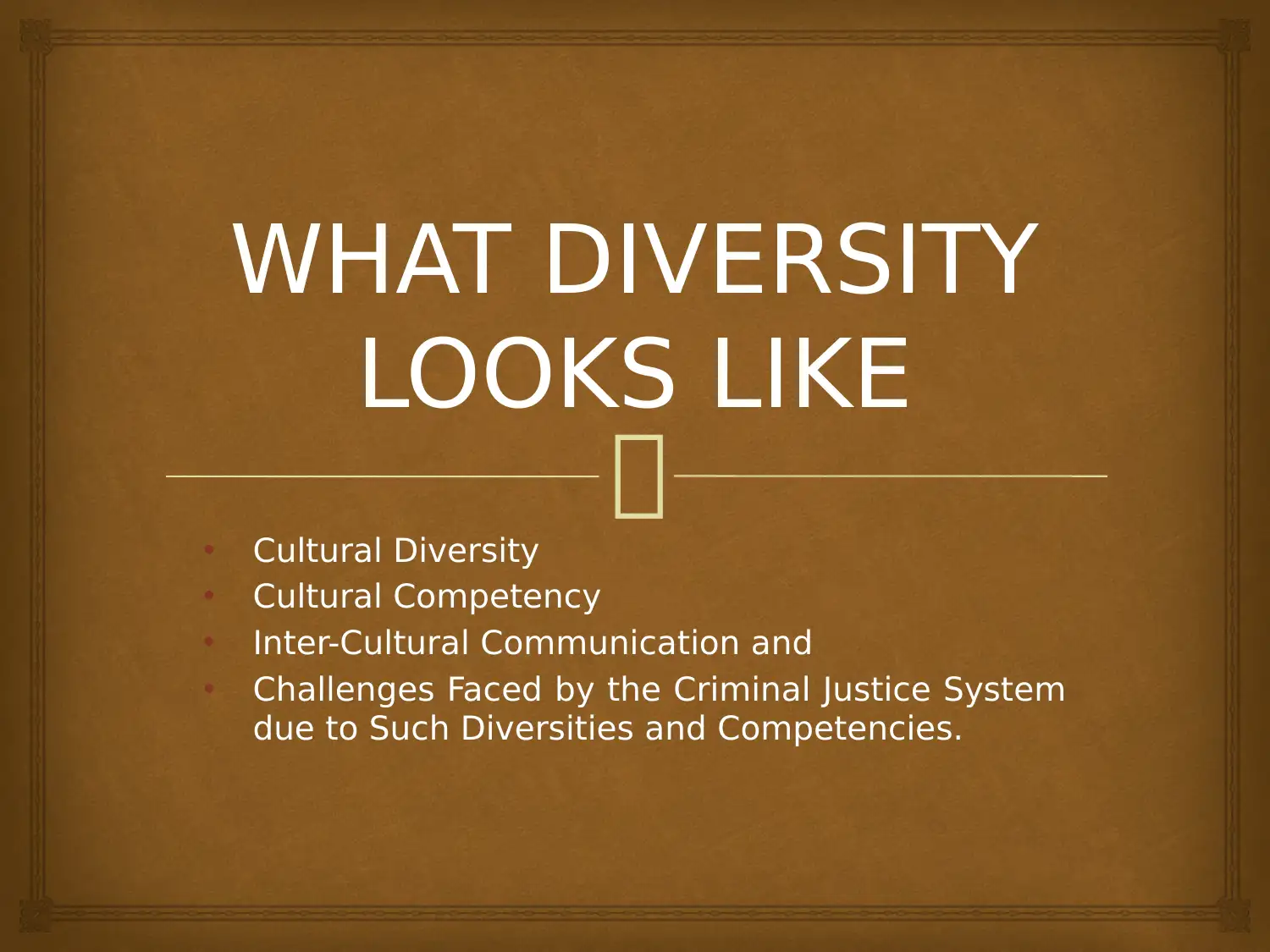
WHAT DIVERSITY
LOOKS LIKE
• Cultural Diversity
• Cultural Competency
• Inter-Cultural Communication and
• Challenges Faced by the Criminal Justice System
due to Such Diversities and Competencies.
WHAT DIVERSITY
LOOKS LIKE
• Cultural Diversity
• Cultural Competency
• Inter-Cultural Communication and
• Challenges Faced by the Criminal Justice System
due to Such Diversities and Competencies.
Paraphrase This Document
Need a fresh take? Get an instant paraphrase of this document with our AI Paraphraser
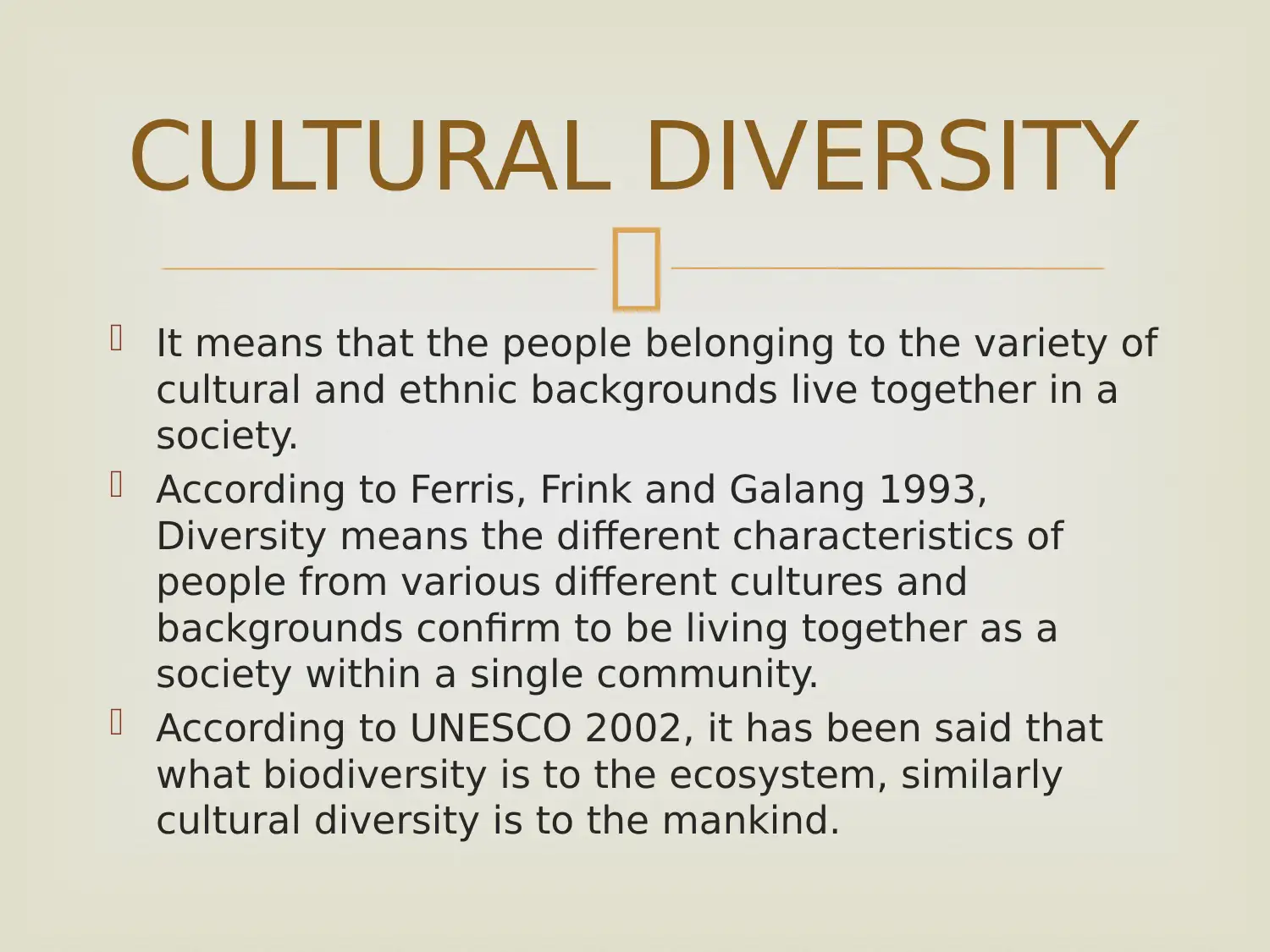
It means that the people belonging to the variety of
cultural and ethnic backgrounds live together in a
society.
According to Ferris, Frink and Galang 1993,
Diversity means the different characteristics of
people from various different cultures and
backgrounds confirm to be living together as a
society within a single community.
According to UNESCO 2002, it has been said that
what biodiversity is to the ecosystem, similarly
cultural diversity is to the mankind.
CULTURAL DIVERSITY
It means that the people belonging to the variety of
cultural and ethnic backgrounds live together in a
society.
According to Ferris, Frink and Galang 1993,
Diversity means the different characteristics of
people from various different cultures and
backgrounds confirm to be living together as a
society within a single community.
According to UNESCO 2002, it has been said that
what biodiversity is to the ecosystem, similarly
cultural diversity is to the mankind.
CULTURAL DIVERSITY
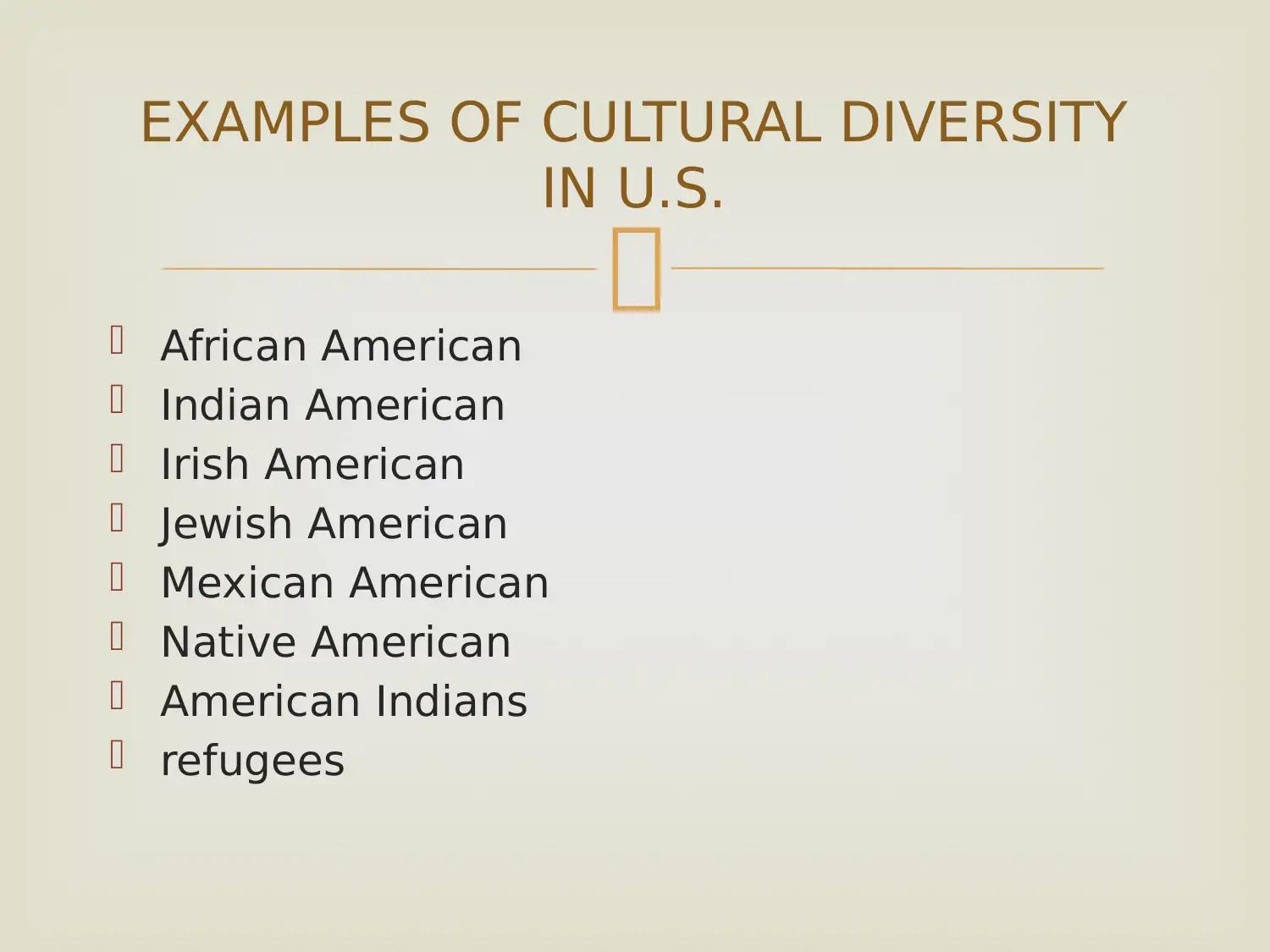
African American
Indian American
Irish American
Jewish American
Mexican American
Native American
American Indians
refugees
EXAMPLES OF CULTURAL DIVERSITY
IN U.S.
African American
Indian American
Irish American
Jewish American
Mexican American
Native American
American Indians
refugees
EXAMPLES OF CULTURAL DIVERSITY
IN U.S.
⊘ This is a preview!⊘
Do you want full access?
Subscribe today to unlock all pages.

Trusted by 1+ million students worldwide
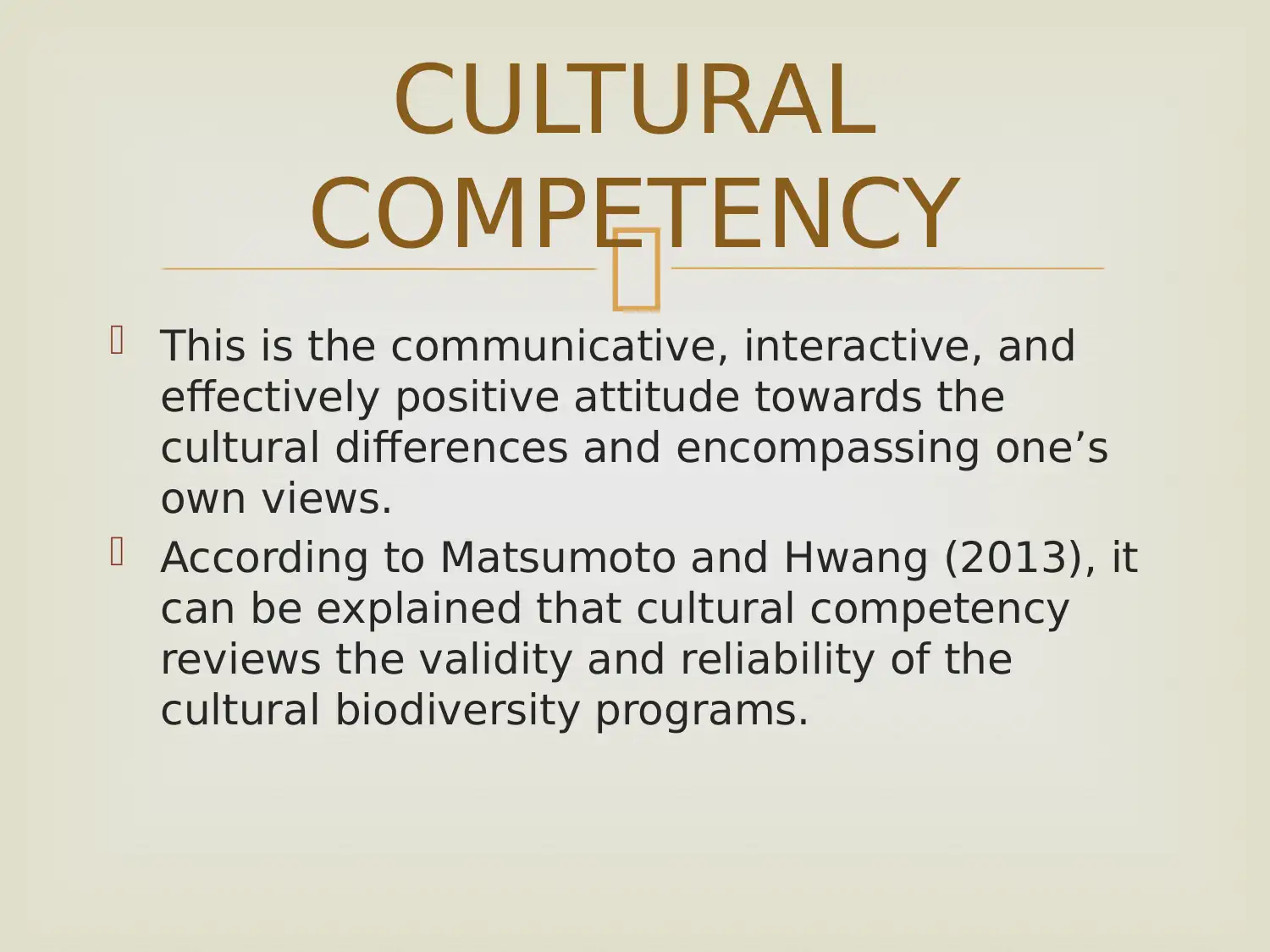
This is the communicative, interactive, and
effectively positive attitude towards the
cultural differences and encompassing one’s
own views.
According to Matsumoto and Hwang (2013), it
can be explained that cultural competency
reviews the validity and reliability of the
cultural biodiversity programs.
CULTURAL
COMPETENCY
This is the communicative, interactive, and
effectively positive attitude towards the
cultural differences and encompassing one’s
own views.
According to Matsumoto and Hwang (2013), it
can be explained that cultural competency
reviews the validity and reliability of the
cultural biodiversity programs.
CULTURAL
COMPETENCY
Paraphrase This Document
Need a fresh take? Get an instant paraphrase of this document with our AI Paraphraser
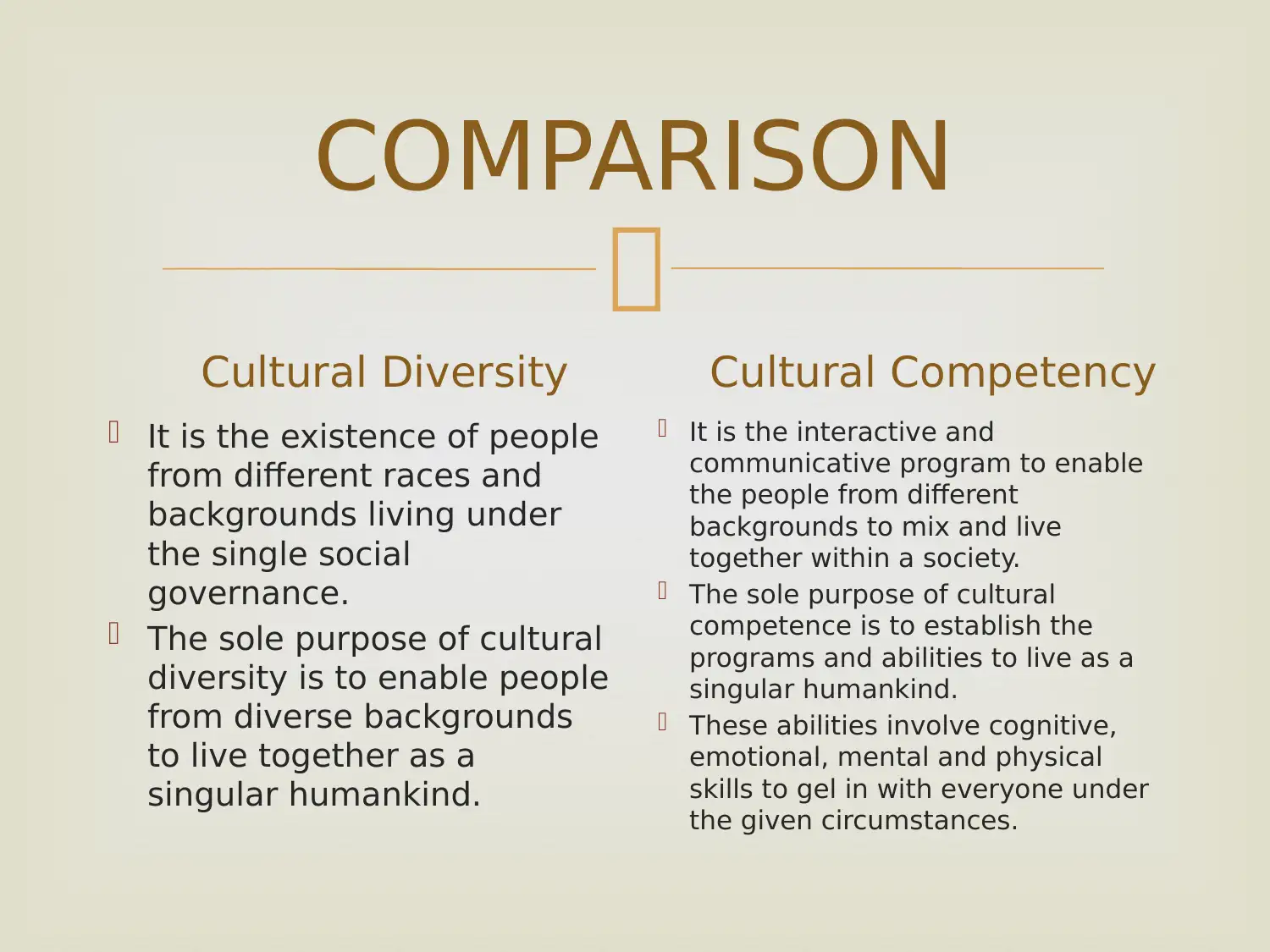
COMPARISON
Cultural Diversity
It is the existence of people
from different races and
backgrounds living under
the single social
governance.
The sole purpose of cultural
diversity is to enable people
from diverse backgrounds
to live together as a
singular humankind.
Cultural Competency
It is the interactive and
communicative program to enable
the people from different
backgrounds to mix and live
together within a society.
The sole purpose of cultural
competence is to establish the
programs and abilities to live as a
singular humankind.
These abilities involve cognitive,
emotional, mental and physical
skills to gel in with everyone under
the given circumstances.
COMPARISON
Cultural Diversity
It is the existence of people
from different races and
backgrounds living under
the single social
governance.
The sole purpose of cultural
diversity is to enable people
from diverse backgrounds
to live together as a
singular humankind.
Cultural Competency
It is the interactive and
communicative program to enable
the people from different
backgrounds to mix and live
together within a society.
The sole purpose of cultural
competence is to establish the
programs and abilities to live as a
singular humankind.
These abilities involve cognitive,
emotional, mental and physical
skills to gel in with everyone under
the given circumstances.
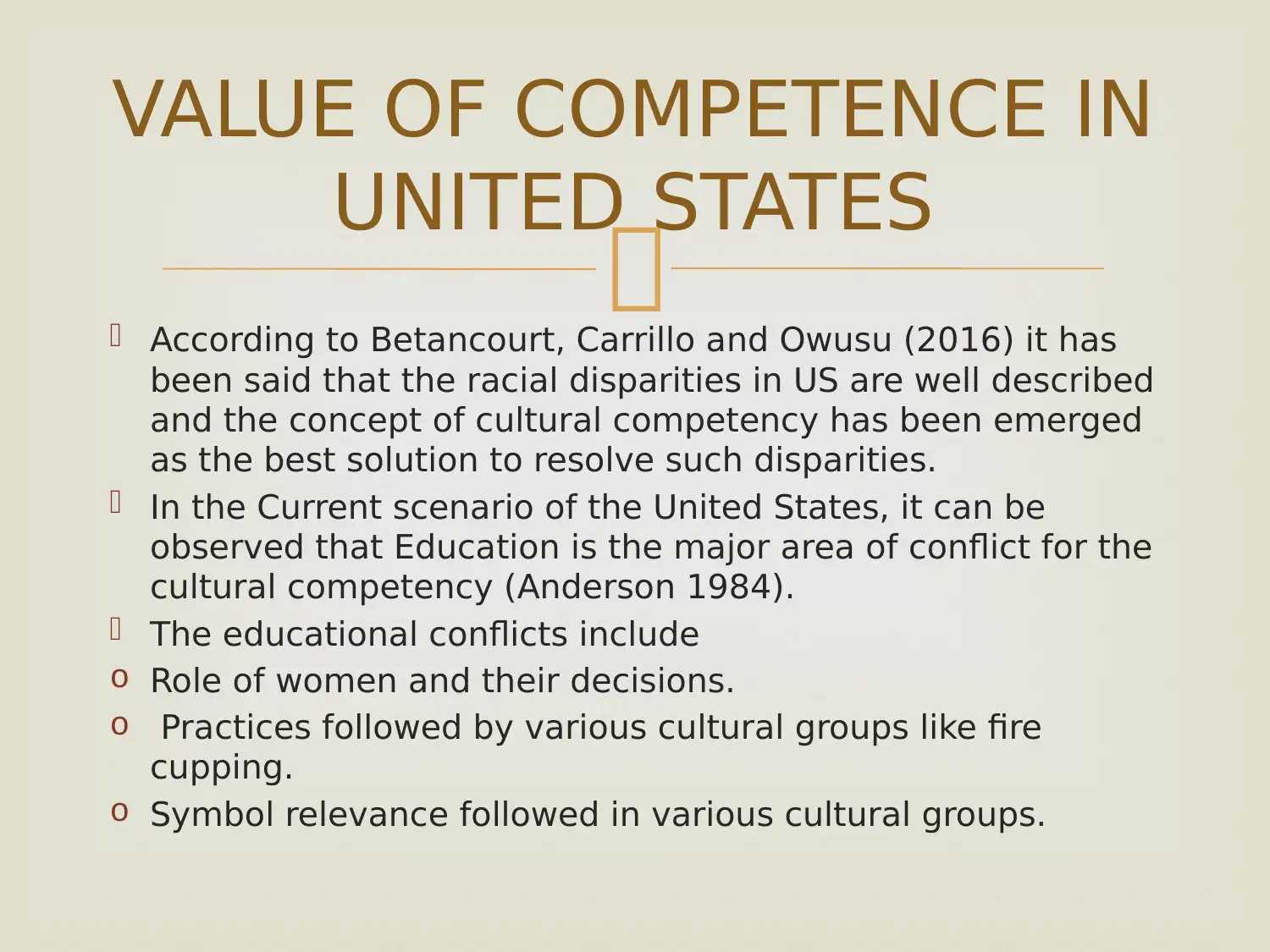
According to Betancourt, Carrillo and Owusu (2016) it has
been said that the racial disparities in US are well described
and the concept of cultural competency has been emerged
as the best solution to resolve such disparities.
In the Current scenario of the United States, it can be
observed that Education is the major area of conflict for the
cultural competency (Anderson 1984).
The educational conflicts include
o Role of women and their decisions.
o Practices followed by various cultural groups like fire
cupping.
o Symbol relevance followed in various cultural groups.
VALUE OF COMPETENCE IN
UNITED STATES
According to Betancourt, Carrillo and Owusu (2016) it has
been said that the racial disparities in US are well described
and the concept of cultural competency has been emerged
as the best solution to resolve such disparities.
In the Current scenario of the United States, it can be
observed that Education is the major area of conflict for the
cultural competency (Anderson 1984).
The educational conflicts include
o Role of women and their decisions.
o Practices followed by various cultural groups like fire
cupping.
o Symbol relevance followed in various cultural groups.
VALUE OF COMPETENCE IN
UNITED STATES
⊘ This is a preview!⊘
Do you want full access?
Subscribe today to unlock all pages.

Trusted by 1+ million students worldwide
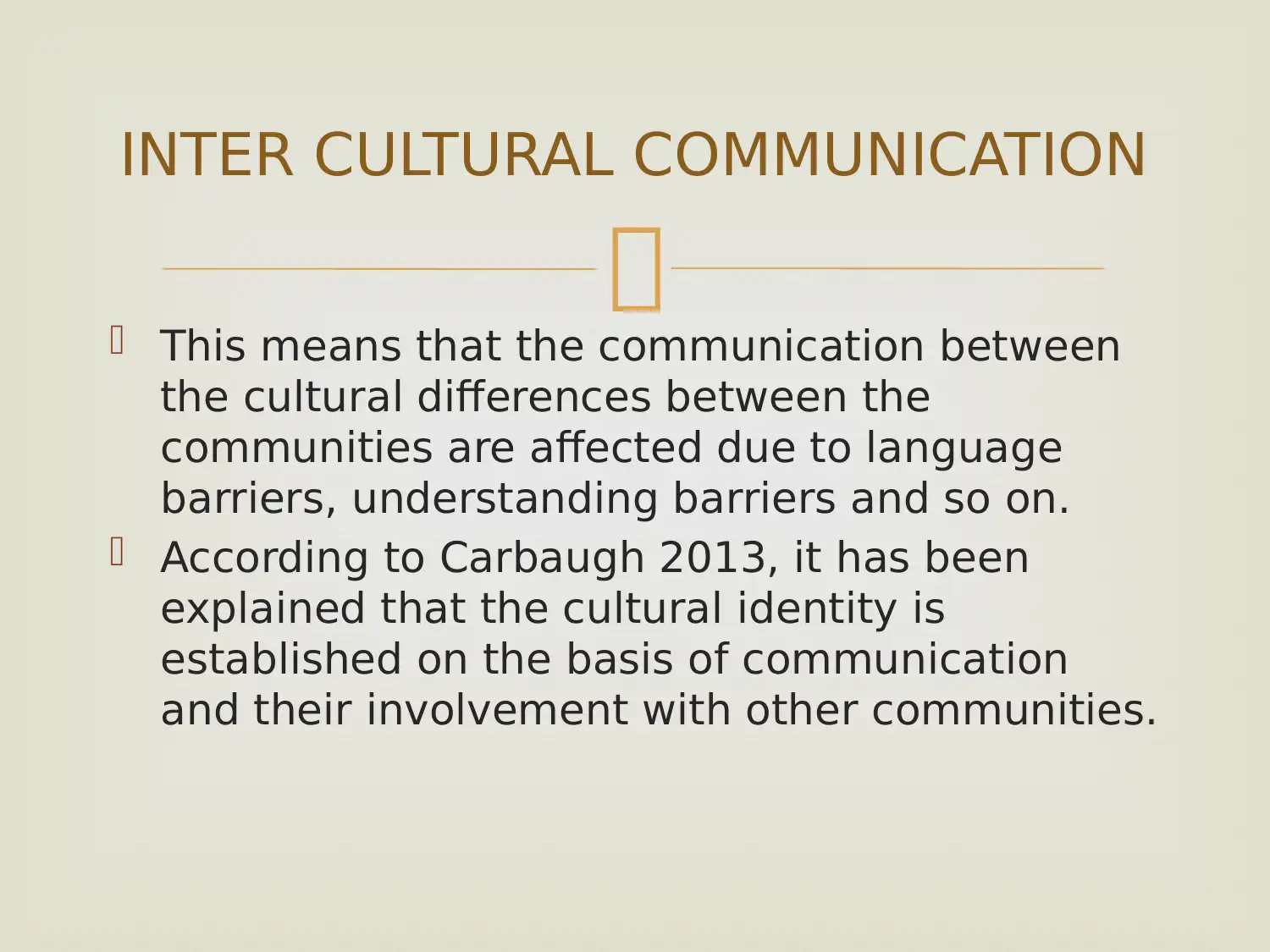
This means that the communication between
the cultural differences between the
communities are affected due to language
barriers, understanding barriers and so on.
According to Carbaugh 2013, it has been
explained that the cultural identity is
established on the basis of communication
and their involvement with other communities.
INTER CULTURAL COMMUNICATION
This means that the communication between
the cultural differences between the
communities are affected due to language
barriers, understanding barriers and so on.
According to Carbaugh 2013, it has been
explained that the cultural identity is
established on the basis of communication
and their involvement with other communities.
INTER CULTURAL COMMUNICATION
Paraphrase This Document
Need a fresh take? Get an instant paraphrase of this document with our AI Paraphraser
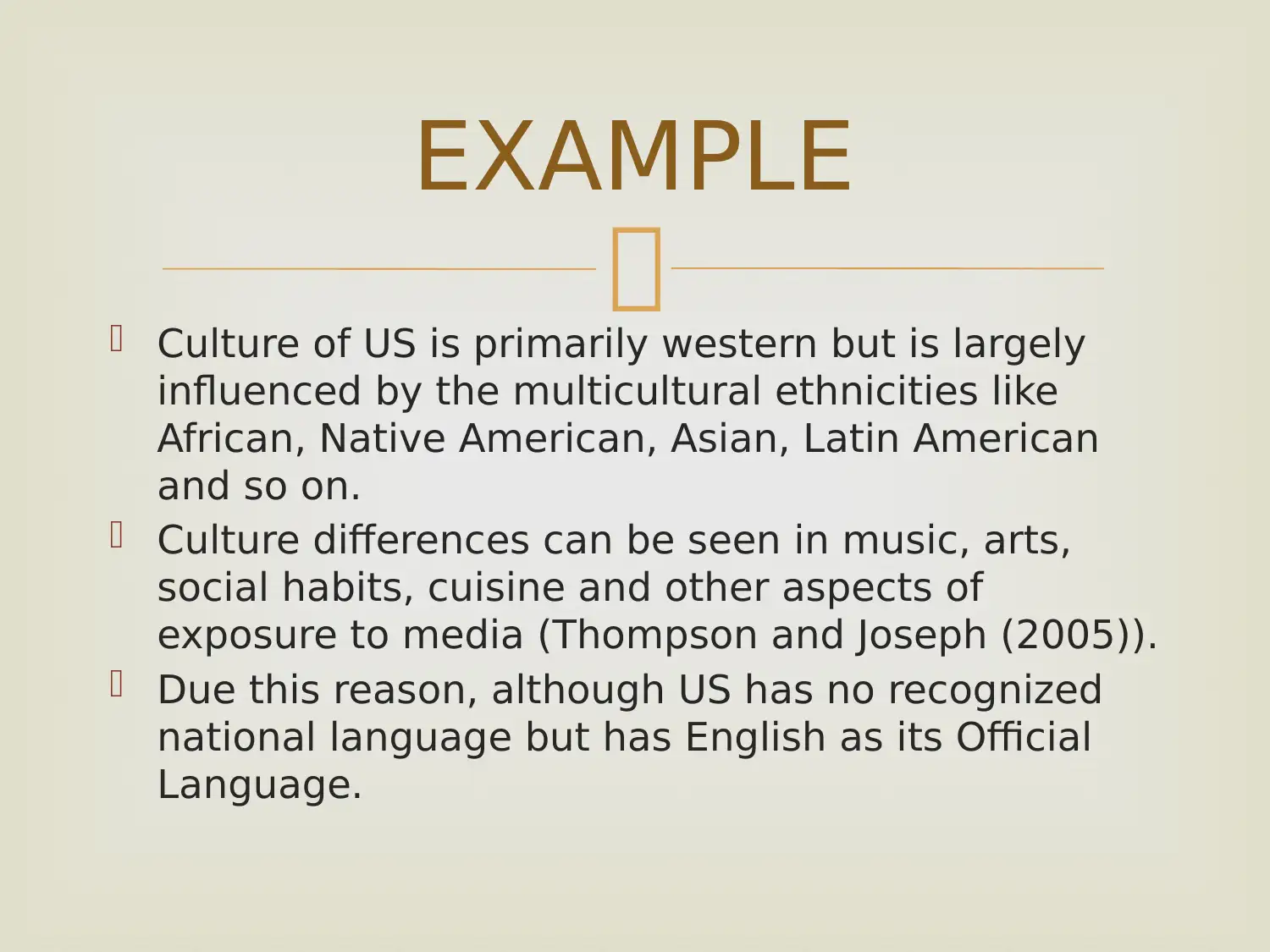
Culture of US is primarily western but is largely
influenced by the multicultural ethnicities like
African, Native American, Asian, Latin American
and so on.
Culture differences can be seen in music, arts,
social habits, cuisine and other aspects of
exposure to media (Thompson and Joseph (2005)).
Due this reason, although US has no recognized
national language but has English as its Official
Language.
EXAMPLE
Culture of US is primarily western but is largely
influenced by the multicultural ethnicities like
African, Native American, Asian, Latin American
and so on.
Culture differences can be seen in music, arts,
social habits, cuisine and other aspects of
exposure to media (Thompson and Joseph (2005)).
Due this reason, although US has no recognized
national language but has English as its Official
Language.
EXAMPLE
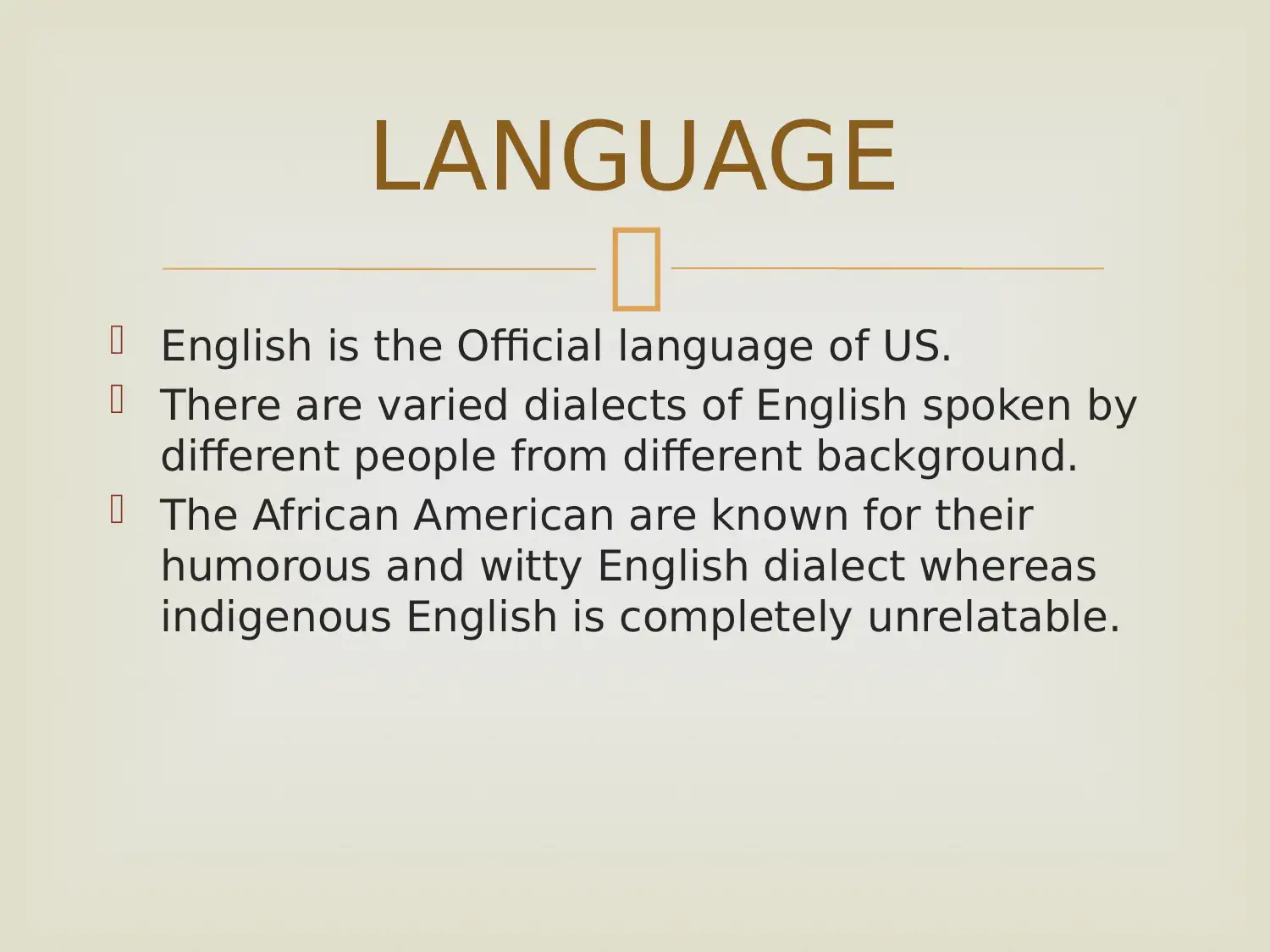
English is the Official language of US.
There are varied dialects of English spoken by
different people from different background.
The African American are known for their
humorous and witty English dialect whereas
indigenous English is completely unrelatable.
LANGUAGE
English is the Official language of US.
There are varied dialects of English spoken by
different people from different background.
The African American are known for their
humorous and witty English dialect whereas
indigenous English is completely unrelatable.
LANGUAGE
⊘ This is a preview!⊘
Do you want full access?
Subscribe today to unlock all pages.

Trusted by 1+ million students worldwide
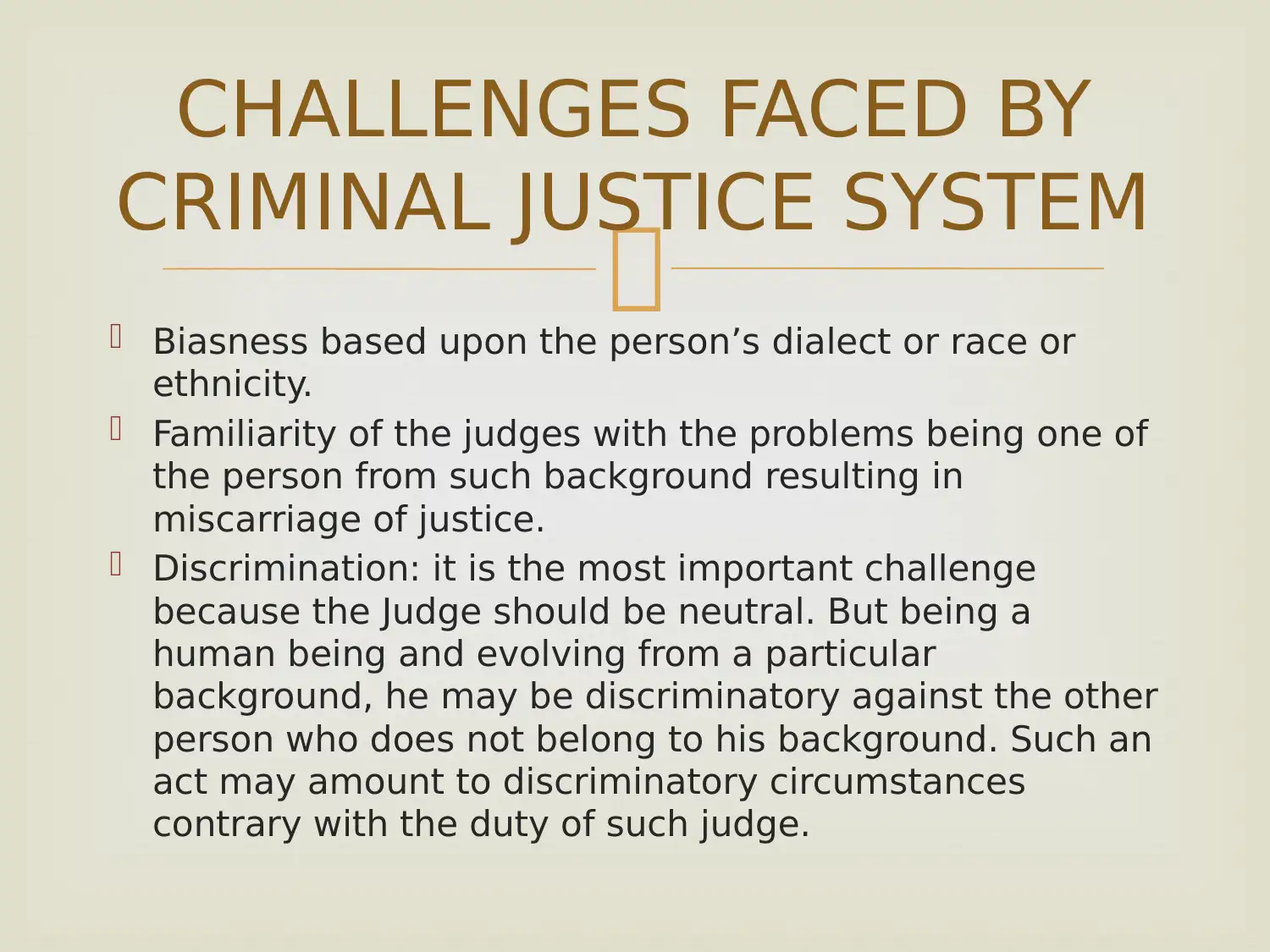
Biasness based upon the person’s dialect or race or
ethnicity.
Familiarity of the judges with the problems being one of
the person from such background resulting in
miscarriage of justice.
Discrimination: it is the most important challenge
because the Judge should be neutral. But being a
human being and evolving from a particular
background, he may be discriminatory against the other
person who does not belong to his background. Such an
act may amount to discriminatory circumstances
contrary with the duty of such judge.
CHALLENGES FACED BY
CRIMINAL JUSTICE SYSTEM
Biasness based upon the person’s dialect or race or
ethnicity.
Familiarity of the judges with the problems being one of
the person from such background resulting in
miscarriage of justice.
Discrimination: it is the most important challenge
because the Judge should be neutral. But being a
human being and evolving from a particular
background, he may be discriminatory against the other
person who does not belong to his background. Such an
act may amount to discriminatory circumstances
contrary with the duty of such judge.
CHALLENGES FACED BY
CRIMINAL JUSTICE SYSTEM
Paraphrase This Document
Need a fresh take? Get an instant paraphrase of this document with our AI Paraphraser
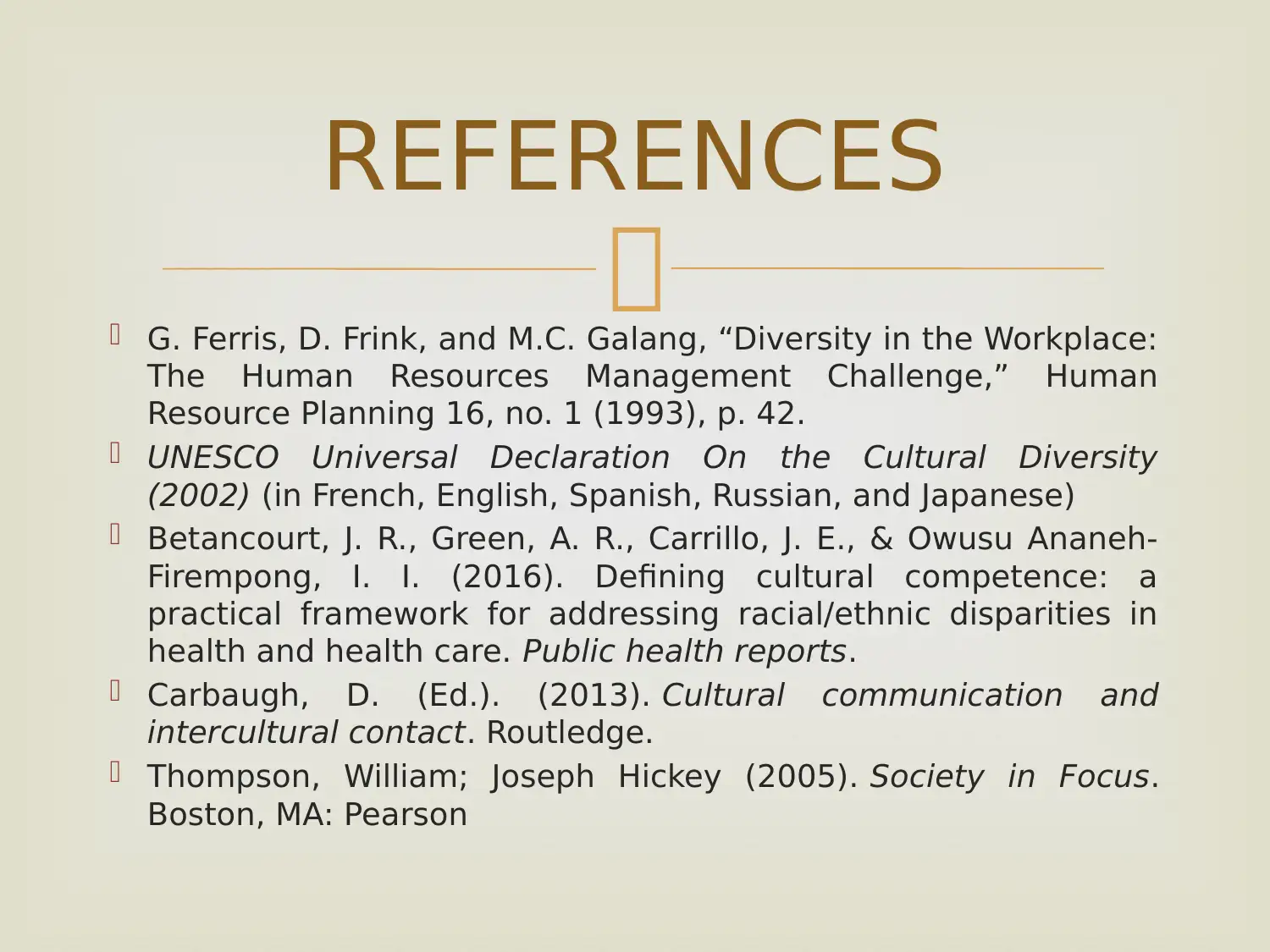
G. Ferris, D. Frink, and M.C. Galang, “Diversity in the Workplace:
The Human Resources Management Challenge,” Human
Resource Planning 16, no. 1 (1993), p. 42.
UNESCO Universal Declaration On the Cultural Diversity
(2002) (in French, English, Spanish, Russian, and Japanese)
Betancourt, J. R., Green, A. R., Carrillo, J. E., & Owusu Ananeh-
Firempong, I. I. (2016). Defining cultural competence: a
practical framework for addressing racial/ethnic disparities in
health and health care. Public health reports.
Carbaugh, D. (Ed.). (2013). Cultural communication and
intercultural contact. Routledge.
Thompson, William; Joseph Hickey (2005). Society in Focus.
Boston, MA: Pearson
REFERENCES
G. Ferris, D. Frink, and M.C. Galang, “Diversity in the Workplace:
The Human Resources Management Challenge,” Human
Resource Planning 16, no. 1 (1993), p. 42.
UNESCO Universal Declaration On the Cultural Diversity
(2002) (in French, English, Spanish, Russian, and Japanese)
Betancourt, J. R., Green, A. R., Carrillo, J. E., & Owusu Ananeh-
Firempong, I. I. (2016). Defining cultural competence: a
practical framework for addressing racial/ethnic disparities in
health and health care. Public health reports.
Carbaugh, D. (Ed.). (2013). Cultural communication and
intercultural contact. Routledge.
Thompson, William; Joseph Hickey (2005). Society in Focus.
Boston, MA: Pearson
REFERENCES

THANK YOU
THANK YOU
⊘ This is a preview!⊘
Do you want full access?
Subscribe today to unlock all pages.

Trusted by 1+ million students worldwide
1 out of 12
Related Documents
Your All-in-One AI-Powered Toolkit for Academic Success.
+13062052269
info@desklib.com
Available 24*7 on WhatsApp / Email
![[object Object]](/_next/static/media/star-bottom.7253800d.svg)
Unlock your academic potential
Copyright © 2020–2025 A2Z Services. All Rights Reserved. Developed and managed by ZUCOL.




